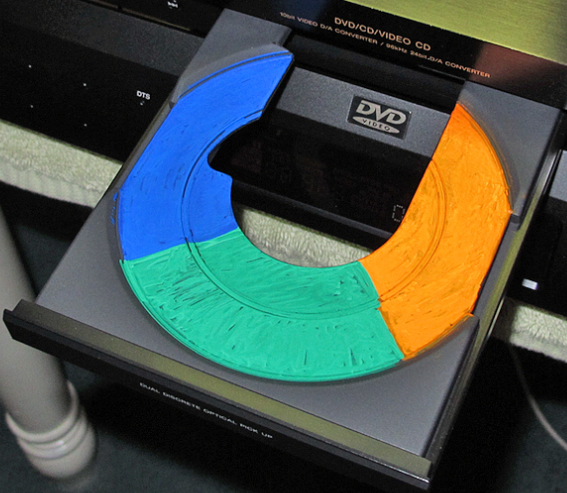You are using an out of date browser. It may not display this or other websites correctly.
You should upgrade or use an alternative browser.
You should upgrade or use an alternative browser.
Anyone heard of painting CD tray Mod ?
- Thread starter Frank Sol
- Start date
Frank Sol
Lunatic Member
kaplang
Works for me !
Works best with "magic pebbles"....Any valid reason for doing so ?
Personally I have not... ran across it today

sKiZo
Hates received: 92644 43.20°N 85.50°W
There's actually a bit of science behind it. I'm sure all you scientific types will have noticed that the colors chosen are all within the spectrum used by the optical disc's laser reader. Coloring the tray can improve the accuracy of the reader's focus and reducing error count by eliminating conflicting spectra that are either too reflective or not reflective enough.
Data on using different colors on the same tray is still out, but speculation is that this schema allows the laser to re-sample a multitude of primaries if needed to reduce error count for difficult passages or inferior pressings, Painting these colors by thirds optimizes the read time based on the turntable revolutions at redbook speeds, keeping the re-samples needed to the bare minimum.
Some have experimented with paper inserts that can supposedly further optimization read accuracy using different colors based on manufacturer's and consumers real world results, optical drive brands, disc condition and age, but the jury's still out on this.
(see note below)
Data on using different colors on the same tray is still out, but speculation is that this schema allows the laser to re-sample a multitude of primaries if needed to reduce error count for difficult passages or inferior pressings, Painting these colors by thirds optimizes the read time based on the turntable revolutions at redbook speeds, keeping the re-samples needed to the bare minimum.
Some have experimented with paper inserts that can supposedly further optimization read accuracy using different colors based on manufacturer's and consumers real world results, optical drive brands, disc condition and age, but the jury's still out on this.
(see note below)
I took note of this additional mod he performed:
"Next I wrapped some tourmaline crystals around the ac interior connection."
I recommend this mod as Maine is a source of tourmaline. By using raspberry pink-red as well as minty green crystals one will help our economy. Thank you. ;-)
Surprised it's not red, yellow and green as that dude is definitely high on something. 

cpt_paranoia
Addicted Member
here's the thread (mods delete if need be)
"Next I wrapped some tourmaline crystals around the ac interior connection."
I think this gives us some insight into the mind of the person who wrote that article...
The Stoplight pen made a definite difference with my Philips based players. Haven't had one in the system in quite a while but still have the treated discs.I wonder if this mod would enhance the green marker on the edge of the CD mod.
Last edited:
Beatnik
What's this ?
Works best with "magic pebbles"....
Fruity or coco ?
dosmalo
T-Totaled
In the '90s after reading about this tray and laser tweak in Stereophile I tried it out on my Carver 490t. It took quite a number of pens but after getting a couple of careful coats on it, it looked almost factory and I was very satisfied with the sound. I was going thru my gear swapping phase and with a number of pieces of equipment put it up on eBay for sale. It got a surprising number of bids and went to a bidder in Alaska for very close to what I paid for it new.The Stoplight pen made a definite difference with my Philips based players. Haven't had one in the system in white a while but still have the treated discs.
If any of you Alaskans owned it, let me know - it's got to be easy to recognize.
Count ChokeUlotz.Fruity or coco ?
cpt_paranoia
Addicted Member
the Sroplight pen on the disc made sense re reflected light confusing the d/a
No it didn't. There is a lot of processing between the read head and the DAC. The read head is an analogue process, and backscattered light might possibly slightly degrade the eye in the data slicer. But that would only potentially cause bit read errors, which will be addressed by the error detection and correction circuits. The data passed to the DAC is digital. If the ECC can't correct the bit errors, it would mute the sample. You'd notice such muting. Backscatter might possibly slightly degrade the servo tracking loops, but the process by which data is passed to the DAC is driven from the DAC end (and the CD drive locks the read servo to that clock). There's a FIFO buffer in the way to sort out read speed variations due to servo 'wobble' that might be caused by backscatter, as well as the deinterleaving buffer. Again, if the servo loops are so badly affected that the buffering is inadequate, you'd notice it.
And, when I say 'notice it', i'm not talking 'a more airy feel'; I'm talking gaps, pops & stuttering.
Backscatter will not 'confuse the d/a'.
Similar threads
- Replies
- 3
- Views
- 260
- Replies
- 4
- Views
- 147



